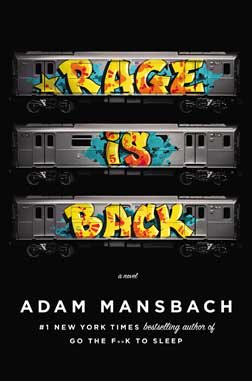While it is set in present day New York, Adam Mansbach's latest novel casts a nostalgic, thought-provoking look back at the past through the history of the city's graffiti culture. You might be aware of Mansbach from Go the F—k to Sleep, possibly the most subversive children's book (obviously aimed at parents) in some time. The book's viral popularity even led to a video featuring Samuel L. Jackson reading the text (it's hilarious as it sounds). Yet Mansbach has been writing fiction for years; like one of Mansbach's previous efforts, Angry Black White Boy, Rage is Back features a witty, intelligent and rebellious protagonist querying the world through his hip-hop-informed lens.
Rage is Back's main character and narrator is Kilroy Dondi Vance, biracial son of legendary yet M.I.A. graffiti writer Rage, freshly ousted from prep school. It's not revealing too much to say his father returns — it is implied in the title — in a magic realism episode on a staircase in the hip Brooklyn neighbourhood Dumbo, no less. However, it is the chain of events his return precipitates, informed by Rage's graffiti past and confrontations with authority, that becomes the novel's concern.
Mansbach infuses 17-year-old Dondi's voice (he's presumably named after the very real but late legendary graffiti writer) with wisdom beyond his years and a street smart sensibility that accompanying hype for Rage is Back has compared to Junot Diaz's Junior character. While Dondi shares his often enthralling gift of gab, he is much more fixated with negotiating his awkward relationship with his father than focusing on women. While the book's plot, particularly in the second half, pushes toward an inevitable conflict between a resurrected band of graffiti writers audaciously intent on righting past injustices in the face of authority, Mansbach uses the generational disconnect to explore a number of latent issues. The spread of gentrification in New York, the 1983 death of graffiti writer Michael Stewart and Henry Chalfant's seminal Style Wars documentary are alluded to and are events Mansbach likely does not want us to forget about. With Rage is Back, much like the best graffiti "wild style" lettering, Mansbach subtly ensures this case, keeping things hidden in plain sight.
You can also check out J.Period's Rage Is Back mixtape, featuring Black Thought, Nas and Shad, here.
Rage is Back's main character and narrator is Kilroy Dondi Vance, biracial son of legendary yet M.I.A. graffiti writer Rage, freshly ousted from prep school. It's not revealing too much to say his father returns — it is implied in the title — in a magic realism episode on a staircase in the hip Brooklyn neighbourhood Dumbo, no less. However, it is the chain of events his return precipitates, informed by Rage's graffiti past and confrontations with authority, that becomes the novel's concern.
Mansbach infuses 17-year-old Dondi's voice (he's presumably named after the very real but late legendary graffiti writer) with wisdom beyond his years and a street smart sensibility that accompanying hype for Rage is Back has compared to Junot Diaz's Junior character. While Dondi shares his often enthralling gift of gab, he is much more fixated with negotiating his awkward relationship with his father than focusing on women. While the book's plot, particularly in the second half, pushes toward an inevitable conflict between a resurrected band of graffiti writers audaciously intent on righting past injustices in the face of authority, Mansbach uses the generational disconnect to explore a number of latent issues. The spread of gentrification in New York, the 1983 death of graffiti writer Michael Stewart and Henry Chalfant's seminal Style Wars documentary are alluded to and are events Mansbach likely does not want us to forget about. With Rage is Back, much like the best graffiti "wild style" lettering, Mansbach subtly ensures this case, keeping things hidden in plain sight.
You can also check out J.Period's Rage Is Back mixtape, featuring Black Thought, Nas and Shad, here.
